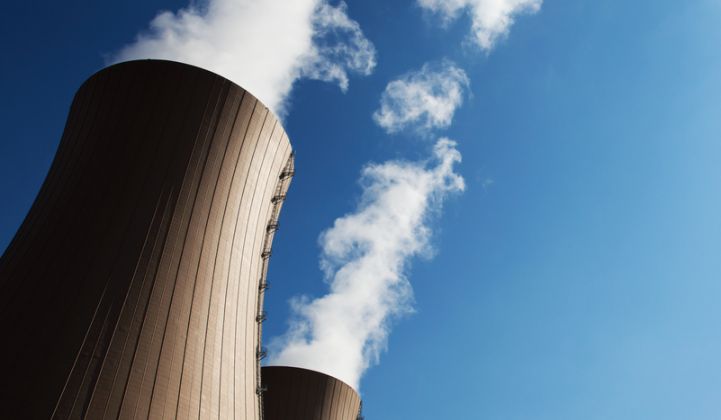The global nuclear industry is in steady decline. Since hitting a peak in 1996 at nearly 18 percent of global energy production, the industry's share has dropped down to less than 11 percent.
Even with countries like China and India looking to boost their low-carbon energy supplies with nuclear, project developers around the world have faced long delays, cost overruns, and strong competition from natural gas and distributed resources, as well as policies designed to phase nuclear out entirely.
America is facing its own imminent decline in nuclear generation. With a wave of aging plants slated for closure in the coming years and almost no plans to replace them, some worry that the country will reverse the recent decline in emissions, potentially even hurting a long-term global deal to reduce carbon pollution.
Nuclear currently makes up 19 percent of the country's generation. If enough plants end up retiring all at once, the government warns that emissions could climb by 4 percent per year. (The actual change will also depend on how many coal plants are retired, how much natural gas is consumed, and how quickly renewables ramp.)
Worried about how the deterioration of America's nuclear fleet will impact climate goals, a group of scientists and energy analysts this week urged a rethinking of U.S. nuclear policy. The separate calls, all made within days of each other, came from a leading Washington-based think tank, 73 conservation scientists and the International Energy Agency (IEA).
"There is a need...to develop and articulate a clear strategy for nuclear power, including a statement of how the federal government will provide long-term support," wrote IEA in its latest review of U.S. energy policy.
A comprehensive federal plan, says IEA, is the only way to keep the industry relevant. Low natural gas and wind prices are challenging the economics of nuclear plants in the U.S., forcing some plant operators to consider retiring older plants ahead of schedule.
"The domestic nuclear industry is therefore at a critical juncture as a consequence of its declining economic competitiveness, and existing market mechanisms do not favor investment in high capital-intensive nuclear technology," concluded the IEA.
Articulating that strategy will not be easy.
On a levelized-cost-of energy basis (an admittedly limited metric), distributed renewables are competing with nuclear plants, adding to the pain inflicted by low natural gas prices. Both free-market advocates and renewable energy proponents say new nuclear shouldn't be built if it can't compete in today's market.
Cost overruns are also hurting the industry's image. The first U.S. nuclear project to be built in 30 years, the Vogtle power plant in Georgia, is now $1.5 billion over budget and getting more expensive. Angry about rate increases caused by Vogtle, the Green Tea Party and environmental groups were able to force Georgia Power to support half a gigawatt of new solar in the state -- much of it procured for 6.5 cents per kilowatt-hour.
Meanwhile, many environmentalists remain staunchly opposed to nuclear for traditional health and safety reasons.
In response, a group of 73 conservation scientists wrote an open letter to green groups on Monday asking them to reconsider their opposition.
"As leading climate scientists have recently advocated the development of safe, next-generation nuclear energy systems to combat global climate change, we entreat the conservation and environmental community to weigh up the pros and cons of different energy sources using objective evidence and pragmatic tradeoffs, rather than simply relying on idealistic perceptions of what is ‘green.'"
The letter was a follow-up to a paper recently published in the journal Conservation Biology, which argued for a nuclear development as a strategy to prevent biodiversity loss.
"Given the historical antagonism toward nuclear energy amongst the environmental community, we accept that this stands as a controversial position," they wrote.
For nuclear to have any chance of succeeding, strong government intervention will be needed to fund more R&D and back loans for commercial-scale plants, say proponents.
In an essay written for the Brookings Institution last Friday, Joshua Freed, the director of energy at the think tank Third Way, outlined the elements needed to support emerging nuclear technologies that can recycle waste, use more diverse fuels, reduce plant size and increase operational safety.
Increasing funding for government labs to create an advanced reactor test facility would be the first step, argued Freed. But the funds set aside for R&D are far below levels needed.
"An unholy and unwitting alliance of right-wing climate deniers, small-government radicals, and liberal anti-nuclear advocates have joined together to keep nuclear lab budgets small," wrote Freed.
As technologies near commercialization, financing support programs like loan guarantees will also be needed, argued Freed. That's an area where the government has been most supportive. Last week, the Department of Energy announced the availability of $12.5 billion in loan guarantees for advanced reactor designs or enrichment processes.
The ambitious goals of nuclear startups "cannot be accomplished by Silicon Valley VC-scale funding," he wrote.
Finally, argued Freed, federal regulators need to change how they approve new power plant designs.
"The NRC [Nuclear Regulatory Commission] makes no pretense of being prepared to evaluate reactors cooled by molten salt or run on depleted uranium. And it insists on pounding these new round pegs into its old square holes, demanding that the new reactors meet the same requirements as the old ones, even when that makes no sense," he wrote.
That kind of government help is unrealistic given today's political and market conditions. But if emissions start creeping back up in the U.S., it's likely that more groups will throw their support behind a next-generation nuclear strategy.



